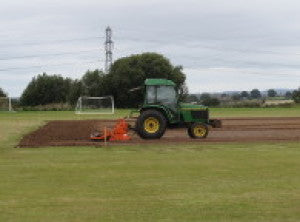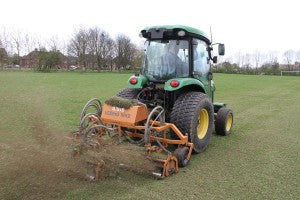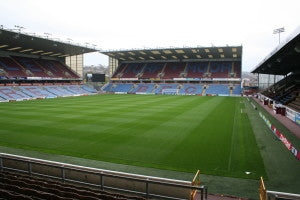The Importance of Renovations

Costs will be determined on what work you have done, a typical end of season renovation on a soil based pitch, undertaking the following work:- scarification, verti-draining (aeration), topdressing (60 tonnes of sand) and overseeding with 12 bags of seed and some fertilisers, will cost anything between £4000-£5000 depending on choice of materials and transport costs.
Weed treatments: At some stage you will need to consider where your weed killing programme fits into the picture of you pitch renovations. Selective weed killers remain persistent in the ground for a number of weeks when sprayed, and this can have an adverse effect on your seedling grasses it not timed properly.
If you have a noticeable amount of weeds present already, then you may be better spraying immediately to eliminate the heavy competition that new grasses will get from the already established weeds. You will, however, need to delay the renovation programme, if this is the case, by some 5 - 6 weeks, but this will ensure that grass seed will be going into the bare areas left behind by the dead weeds.

I feel it necessary to advise some caution at this point. If you are thinking about weed control, then you should always pay good regard to the prevailing weather patterns. Remember that it is inadvisable to spray during periods of drought. This makes sense economically for two reasons: during dry weather, plant growth slows and, remembering that selective weed killers are generally systemic in nature, being drawn from the leaf to the plant's areas of metabolic activity, they will not move so readily into the plant, making your application less effective. Secondly, you are at risk if you spray when the grass is suffering from drought stress, of having a marked and, in some cases, fatal effect on your grass, giving you the added expense of re-seeding.

A tractor drawn rake, followed by a box mower, is probably the most traditional method and most likely within the means of most clubs and schools. You may also have use of a pick up flail mower, in which case you may find that scarifying tines can be fitted, allowing the job to be completed in one operation. This method can be advantageous, as the scarifying tines can leave a grooved surface, ideal for ensuring oversown grass seed is buried just beneath the soil surface and in contact with the soil.
Whichever method you use, you will be aiming to achieve a surface that is short and clean, with a finished mown height of 13 to 20mm, that will give your grass seedlings time to grow and establish without competing too much from the existing grasses.
Koroing is an operation that is becoming popular to those that can afford it (mostly Premiership clubs fall into this bracket).
Koro topping ( Fraise Mowing ) is extremely efficient at removing the top organic layer of the pitch, however; you will effectively be starting again with a newly sown surface, so your seeding rates will need to be higher.

Remember to check the depth of existing under soil drainage or soil heating before carrying out deep spiking. Pay particular attention to your goalmouth and centre spot areas, and don't forget also the off pitch areas where your linesmen and spectators stand.
Fertilising: A good pre-seeding fertiliser, typically one low in nitrogen and high in phosphorus and potash, will provide the young seedlings with the essential nutrients to root quickly and to resist disease. This should be knocked off the leaf of the plant using a brush or dragmat to avoid scorching. Water in if rain is not expected.
Seeding: Obtain a good quality rye grass seed mixture for your renovation. Fresh seed is important as old seed will not germinate as greatly or as well as new. .
Oversow at the rate of 20 to 35g/m2. Personally, I like to sow with some in hand in case I need to oversow any thin areas later on. The important thing is to get good seed to soil contact to ensure good seed germination. This can be achieved in a number of ways depending on the equipment you have to hand.
If you have a Quadraplay, for instance, you could start by surface spiking, oversowing and then continue to work the seed into the surface using the surface spiking unit and brush unit. Traverse the pitch in as many different directions as possible to work the seed into the surface. (Quadraplay or not, the important thing is to get as many surface holes as possible for the seed to work its way into the surface, so a sarrel roller could complete this task equally well in combination with a brush).
The roller can be lowered on the final run to firm the surface and ensure good soil to seed contact. Alternatively, the use of seed drills will help to bury the seed into the surface and at a depth where it won't be subject to drying out. This method will produce a linear seeding pattern and it is best to complete two passes, or more, at a slight angle to the first.

If you are using a general topdressing, of say 70/30, you should be aware that this could have high clay content, despite the high percentage of sand, and could give you some problems later. It would be wise to ensure you know what is being supplied. If you cannot afford to topdress, you may consider hollow coring, recycling them by breaking them up and dragmatting them back into the surface. If the construction of your pitch is a sand slit system, then topdressing regularly with compatible sand will be required to ensure that the slits do not become capped over.
There are two main functions of topdressings here, the first being to cover the grass seed to achieve good soil to seed contact that will ensure good germination of an expensive resource; secondly to restore surface levels.
Low areas in the pitch can be concentrated on. Usually, low areas, minor dips and hollows that collect water, noted during the winter, can be further spiked. A slightly heavier topdressing spread than the surrounding area will help to raise these areas, though be careful to ensure the topdressing is worked into the holes and into the base of the sward. The topdressing should not be thick and left covering the top of the grass, as this will only lead to a weakened sward. Repeat the operation if necessary and check it with a straight edge.
Goalmouth and centre spot areas: At this time of year, how much grass is still around in these areas depends on a number of factors, and is a combination of the condition of the sward at the start of the season, number of games played, the conditions that they were played in and, finally, the adopted post match and winter maintenance regimes.
Suffice to say that the wear can range from minimal, with some pitches sustaining little loss of grass in the goalmouth area, to an area or strip, if you like, running the whole length of the pitch, completely devoid of grass cover. Some goalmouth areas may even have lost both grass cover and soil, where the soil has migrated out of the area. In these areas, it is important that they receive more concentrated effort to relieve compaction and to bring the surface levels back.

Mowing heights for football pitches will be dependant on what level of football pitch you are maintaining, and sometimes be goveren by what mowers you are using. However, in the main you should be mowing at a height of cut (HOC) between 25mm-35mm.
Watering:- June is when soils can dry out quickly as we move later into the month. Make sure that your irrigation systems are functioning as, once soils become hydrophobic and dry patch sets in, it becomes very difficult to get water back into the surface. If you follow a programme of using wetting agents to ensure a uniform wetting, this will help, particularly on soils prone to dry patch.
Turf treatments: Some turf treatments work well for some, and there are a number of them to choose from, such as organic based micronutrients, seaweed treatments, clay flocculants, amino acids and plant growth regulators such as Primo Maxx. It can sometimes be difficult to assess the benefits of such treatments, but most managers will notice if it has been effective or not. If you are unsure, then ask your supplier for a trial amount and test it for yourself. I'm sure they would be pleased to accommodate you.
Pitchcare have recently launched a new independent Soil Anaylsis service that enable you to get specific results for the soils you manage. Soil analysis is a means to discover what levels of nutrients are available to plants. There is an optimum for each plant nutrient and, when coupled with other properties such as soil structure and particle sizes, determine how vigorous your plants are. Different nutrients undertake different tasks within the plant.
June is also a good month for applying summer fertiliser products. Ideally, it is good practice to undertake at least an annual soil test to analyse the nutrient status of your soil. This will help ensure you only apply what is required and not waste money and time applying products you do not need.
However, the choice of materials and how well it works can be dependant on many factors, including soil type and the weather, with moisture and warmer air temperatures being the catalyst for growth.

As for broadleaf weed control, a timley application of a selective herbicide will help control any weeds, however, you may have to delay your application if you have newley germinated seed; it would then be best to apply mid to late August. Use an approved selective herbicide.
The results of your labour and investment should, without doubt, provide you with a very good playing surface for the forthcoming season.
A range of renovation products/materials can be sourced from the Pitchcare Shop
